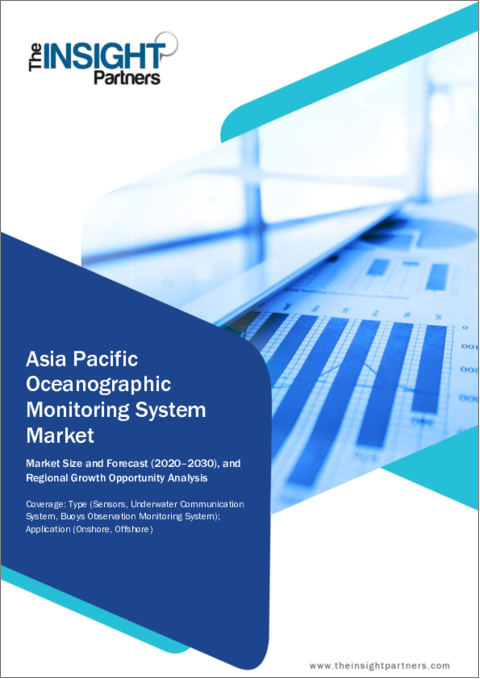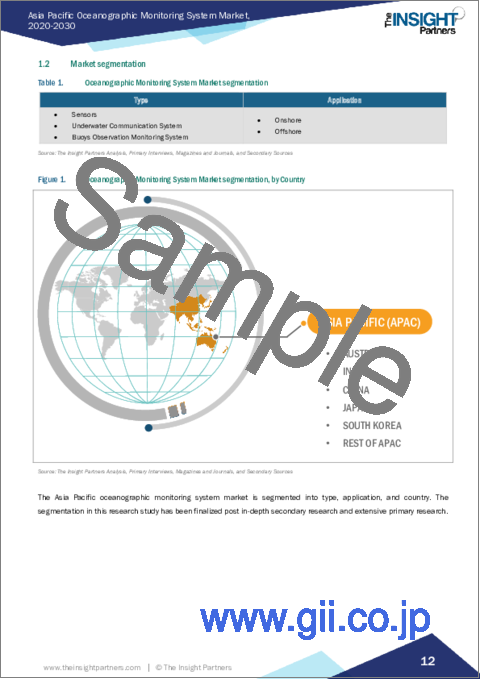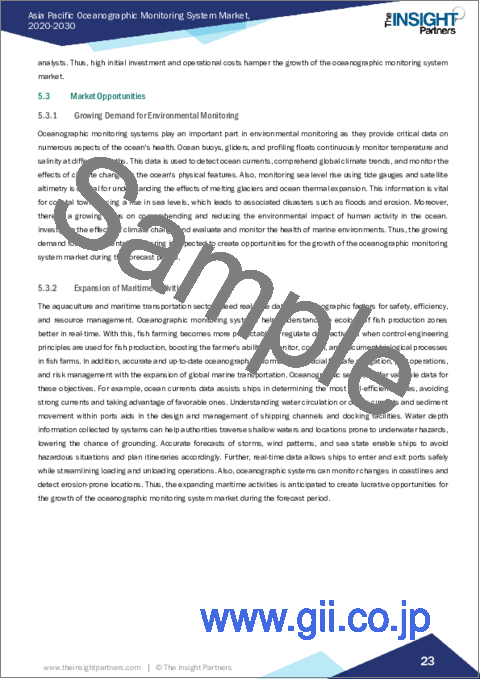|
|
市場調査レポート
商品コード
1637696
アジア太平洋の海洋監視システム市場:2030年までの予測 - 地域別分析 - タイプ別、用途別Asia Pacific Oceanographic Monitoring System Market Forecast to 2030 - Regional Analysis - by Type (Sensors, Underwater Communication System, and Buoys Observation Monitoring System) and Application (Onshore and Offshore) |
||||||
|
|||||||
| アジア太平洋の海洋監視システム市場:2030年までの予測 - 地域別分析 - タイプ別、用途別 |
|
出版日: 2024年11月22日
発行: The Insight Partners
ページ情報: 英文 80 Pages
納期: 即納可能
|
- 全表示
- 概要
- 図表
- 目次
アジア太平洋の海洋監視システム市場は、2022年に3億2,121万米ドルとなり、2030年までには5億796万米ドルに達すると予測され、2022年から2030年までのCAGRは5.9%を記録すると予測されています。
環境監視需要の高まりがアジア太平洋の海洋監視システム市場を後押し
海洋監視システムは、海洋の健全性の多くの側面に関する重要なデータを提供するため、環境監視において重要な役割を果たしています。海洋ブイ、グライダー、プロファイリングフロートは、異なる深度における水温と塩分濃度を継続的に監視しています。このデータは、海流の検出、世界の気候動向の把握、気候変動が海洋の物理的特徴に及ぼす影響の監視に使用されます。また、潮位計や衛星高度計を使った海面上昇の監視は、氷河の融解や海洋の熱膨張の影響を理解するために不可欠です。この情報は、洪水や浸食などの関連災害につながる海面上昇に直面している沿岸の町にとって不可欠です。さらに、気候変動の影響を調査し、海洋環境の健全性を評価・監視することで、海洋における人間活動が環境に与える影響を理解し、その影響を軽減することに注目が集まっています。このように、環境監視に対する需要の高まりは、予測期間中に海洋学的監視システム市場の成長機会を生み出すと期待されています。
アジア太平洋の海洋監視システム市場概要
アジア太平洋の海洋監視システム市場は、オーストラリア、中国、インド、日本、韓国、その他アジア太平洋に区分されます。これらの国々は、海洋現象に関するデータを収集する複数のステーションを設立しています。例えば、オーストラリア国立係留網(ANMN)は、多数の国立基準局と地域係留アレイで構成されています。これらの海洋係留施設は、さまざまな深度における潮流、水温、塩分、その他の水質特性に関するデータを収集しています。オーストラリア海洋科学研究所(AIMS)は、グレートバリアリーフとオーストラリア北部全域の係留施設を管理しています。さらにAIMSは、オーストラリアの7つの国立基準局のうち2つを管理・維持しています。難破船SSヨンガラの近くに位置するQ-IMOSグレートバリアリーフ国立基準局と、IMOSダーウィン国立基準局は、海流、波浪、気象、水温、塩分、プランクトン、水質/生物地球化学を含む海洋状況に関する長期ベースライン・データを収集しています。
さらにインドは、津波を検知するための水圧を測定するさまざまな機器を開発・配備しています。例えば、2023年5月、ソナーダイン社は深海音響センサーのネットワークを更新し、インドの沿岸地域社会に津波の早期警報を提供しています。このセンサーはアラビア海とベンガル湾の重要な場所に配備されており、Sonardyneの底圧記録装置(BPR)のネットワークは、インドの津波早期警報システム(TEWS)の一環として、インドの国立海洋技術研究所(NIOT)によって維持・運用されています。BPRは、深海での地震による水圧の特徴的な変化(水深4,000mでわずか1cm)を検出します。したがって、このようなセンサーの開発の高まりは、海洋監視システムの需要を生み出しています。
アジア太平洋の海洋監視システム市場の収益と2030年までの予測(金額)
アジア太平洋の海洋監視システム市場のセグメンテーション
アジア太平洋の海洋監視システム市場は、タイプ、用途、国に分類されます。
タイプ別では、アジア太平洋の海洋監視システム市場は、センサー、水中通信システム、ブイ観測監視システムに分類されます。センサセグメントは、2022年に最大の市場シェアを占めました。
用途では、アジア太平洋の海洋監視システム市場は陸上と海洋に二分されます。2022年の市場シェアは陸上セグメントが大きくなりました。
国別では、アジア太平洋の海洋監視システム市場は、オーストラリア、中国、日本、インド、韓国、その他アジア太平洋に区分されます。2022年のアジア太平洋の海洋監視システム市場シェアは中国が独占しました。
GOST Global、Hitachi Zosen Corporation、Sonardyne、Xylem、Trelleborg Marine and Infrastructure、Sercel、MOBILIS、Smart Buoy Coは、アジア太平洋の海洋監視システム市場で事業を展開している主要企業です。
目次
第1章 イントロダクション
第2章 エグゼクティブサマリー
- 主要洞察
- 市場の魅力
第3章 調査手法
- 調査範囲
- 2次調査
- 1次調査
第4章 海洋監視システム市場情勢
- 概観
- PEST分析
- エコシステム分析
- バリューチェーンのベンダー一覧
第5章 アジア太平洋の海洋監視システム市場:主要市場力学
- 市場促進要因
- 海洋監視への政府投資の増加
- 津波、高潮、異常波の発生の増加
- 持続可能な海洋管理に対する需要の高まり
- 市場抑制要因
- 初期投資と運用コストの高さ
- 市場機会
- 環境監視の需要拡大
- 海洋活動の拡大
- 今後の動向
- 海洋データ収集のための自律型海中ロボットと無人水上ビークルの導入
- リモートセンシング技術と衛星画像の利用
- 促進要因と抑制要因の影響
第6章 海洋監視システム市場:アジア太平洋市場分析
- 海洋監視システム市場の収益、2020年~2030年
- 海洋監視システム市場の予測分析
第7章 アジア太平洋の海洋監視システム市場分析:タイプ別
- センサー
- 水中通信システム
- ブイ観測監視システム
第8章 アジア太平洋の海洋監視システム市場分析:用途別
- オンショア
- オフショア
第9章 アジア太平洋の海洋監視システム市場:国別分析
- アジア太平洋
- 中国
- 日本
- インド
- オーストラリア
- 韓国
- アジア太平洋のその他諸国
第10章 競合情勢
- ヒートマップ分析:主要企業別
- 企業のポジショニングと集中度
第11章 業界情勢
- 市場イニシアティブ
- 新製品開発
第12章 企業プロファイル
- GOST Global
- Hitachi Zosen Corporation
- Sonardyne
- Xylem
- Trelleborg Marine and Infrastructure
- SERCEL
- MOBILIS
- Smart Buoy Co.
第13章 付録
List Of Tables
- Table 1. Oceanographic Monitoring System Market segmentation
- Table 2. List of Vendors
- Table 3. Oceanographic Monitoring System Market - Revenue and Forecast to 2030 (US$ Million)
- Table 4. Oceanographic Monitoring System Market - Revenue and Forecast to 2030 (US$ Million) - by Type
- Table 5. Oceanographic Monitoring System Market - Revenue and Forecast to 2030 (US$ Million) - by Application
- Table 6. Asia Pacific: Oceanographic Monitoring System Market - Revenue and Forecast to 2030(US$ Million) - by Country
- Table 7. China: Oceanographic Monitoring System Market - Revenue and Forecast to 2030(US$ Million) - by Type
- Table 8. China: Oceanographic Monitoring System Market - Revenue and Forecast to 2030(US$ Million) - by Application
- Table 9. Japan: Oceanographic Monitoring System Market - Revenue and Forecast to 2030(US$ Million) - by Type
- Table 10. Japan: Oceanographic Monitoring System Market - Revenue and Forecast to 2030(US$ Million) - by Application
- Table 11. India: Oceanographic Monitoring System Market - Revenue and Forecast to 2030(US$ Million) - by Type
- Table 12. India: Oceanographic Monitoring System Market - Revenue and Forecast to 2030(US$ Million) - by Application
- Table 13. Australia: Oceanographic Monitoring System Market - Revenue and Forecast to 2030(US$ Million) - by Type
- Table 14. Australia: Oceanographic Monitoring System Market - Revenue and Forecast to 2030(US$ Million) - by Application
- Table 15. South Korea: Oceanographic Monitoring System Market - Revenue and Forecast to 2030(US$ Million) - by Type
- Table 16. South Korea: Oceanographic Monitoring System Market - Revenue and Forecast to 2030(US$ Million) - by Application
- Table 17. Rest of APAC: Oceanographic Monitoring System Market - Revenue and Forecast to 2030(US$ Million) - by Type
- Table 18. Rest of APAC: Oceanographic Monitoring System Market - Revenue and Forecast to 2030(US$ Million) - by Application
- Table 19. Heat Map Analysis by Key Players
List Of Figures
- Figure 1. Oceanographic Monitoring System Market segmentation, by Country
- Figure 2. PEST Analysis
- Figure 3. Ecosystem Analysis
- Figure 4. Oceanographic Monitoring System Market - Key Market Dynamics
- Figure 5. Impact Analysis of Drivers and Restraints
- Figure 6. Oceanographic Monitoring System Market Revenue (US$ Million), 2020-2030
- Figure 7. Oceanographic Monitoring System Market Share (%) - by Type (2022 and 2030)
- Figure 8. Sensors: Oceanographic Monitoring System Market - Revenue and Forecast to 2030 (US$ Million)
- Figure 9. Underwater Communication System: Oceanographic Monitoring System Market - Revenue and Forecast to 2030 (US$ Million)
- Figure 10. Buoys Observation Monitoring System: Oceanographic Monitoring System Market - Revenue and Forecast to 2030 (US$ Million)
- Figure 11. Oceanographic Monitoring System Market Share (%) - by Application (2022 and 2030)
- Figure 12. Onshore: Oceanographic Monitoring System Market - Revenue and Forecast to 2030 (US$ Million)
- Figure 13. Offshore: Oceanographic Monitoring System Market - Revenue and Forecast to 2030 (US$ Million)
- Figure 14. Asia Pacific: Oceanographic Monitoring System Market, by Key Country - Revenue (2022) (US$ Million)
- Figure 15. Asia Pacific: Oceanographic Monitoring System Market Breakdown, by Key Countries, 2022 and 2030 (%)
- Figure 16. China: Oceanographic Monitoring System Market - Revenue and Forecast to 2030(US$ Million)
- Figure 17. Japan: Oceanographic Monitoring System Market - Revenue and Forecast to 2030(US$ Million)
- Figure 18. India: Oceanographic Monitoring System Market - Revenue and Forecast to 2030(US$ Million)
- Figure 19. Australia: Oceanographic Monitoring System Market - Revenue and Forecast to 2030(US$ Million)
- Figure 20. South Korea: Oceanographic Monitoring System Market - Revenue and Forecast to 2030(US$ Million)
- Figure 21. Rest of APAC: Oceanographic Monitoring System Market - Revenue and Forecast to 2030(US$ Million)
- Figure 22. Company Positioning & Concentration
The Asia Pacific oceanographic monitoring system market was valued at US$ 321.21 million in 2022 and is expected to reach US$ 507.96 million by 2030; it is estimated to record a CAGR of 5.9% from 2022 to 2030.
Growing Demand for Environmental Monitoring Fuels Asia Pacific Oceanographic Monitoring System Market
Oceanographic monitoring systems play an important part in environmental monitoring as they provide critical data on numerous aspects of the ocean's health. Ocean buoys, gliders, and profiling floats continuously monitor temperature and salinity at different depths. This data is used to detect ocean currents, comprehend global climate trends, and monitor the effects of climate change on the ocean's physical features. Also, monitoring sea level rise using tide gauges and satellite altimetry is critical for understanding the effects of melting glaciers and ocean thermal expansion. This information is vital for coastal towns facing a rise in sea levels, which leads to associated disasters such as floods and erosion. Moreover, there is a growing focus on comprehending and reducing the environmental impact of human activity in the ocean. investigate the effects of climate change and evaluate and monitor the health of marine environments. Thus, the growing demand for environmental monitoring is expected to create opportunities for the growth of the oceanographic monitoring system market during the forecast period.
Asia Pacific Oceanographic Monitoring System Market Overview
The Asia Pacific oceanographic monitoring system market is segmented into Australia, China, India, Japan, South Korea, and the Rest of Asia Pacific. These countries have established several stations that collect data on oceanographic phenomena. For example, the Australian National Moorings Network (ANMN) consists of a number of National Reference Stations and regional mooring arrays. These oceanographic moorings collect data on currents, temperature, salinity, and other water quality characteristics at various depths. Australia Institute of Marine Science (AIMS) manages moorings on the Great Barrier Reef and across northern Australia. Further, AIMS manages and maintains two of Australia's seven National Reference Stations. The Q-IMOS Great Barrier Reef National Reference Station, situated near the wreck of the SS Yongala, and the IMOS Darwin National Reference Station collect long-term baseline data on ocean conditions that include currents, waves, weather, temperature, salinity, plankton, and water quality/biogeochemistry.
Moreover, India is developing and deploying various equipment to measure water pressure to detect tsunami waves. For example, in May 2023, Sonardyne updated a network of deep-water acoustic sensors that offers India's coastal communities an early warning of tsunami waves. The sensors are deployed at significant locations in the Arabian Sea and the Bay of Bengal; the network of Sonardyne's Bottom Pressure Recorders (BPRs) is maintained and operated by India's National Institute of Ocean Technology (NIOT) as part of the country's Tsunami Early Warning System (TEWS). The BPRs detect the distinctive changes in water pressure (as minute as 1cm in 4,000m depth) affected by an earthquake in the deep ocean. Thus, the rising development of such sensors creates demand for oceanographic monitoring systems.
Asia Pacific Oceanographic Monitoring System Market Revenue and Forecast to 2030 (US$ Million)
Asia Pacific Oceanographic Monitoring System Market Segmentation
The Asia Pacific oceanographic monitoring system market is categorized into type, application, and country.
Based on type, the Asia Pacific oceanographic monitoring system market is categorized into sensors, underwater communication system, and buoys observation monitoring systems. The sensors segment held the largest market share in 2022.
In terms of application, the Asia Pacific oceanographic monitoring system market is bifurcated into onshore and offshore. The onshore segment held a larger market share in 2022.
By country, the Asia Pacific oceanographic monitoring system market is segmented into Australia, China, Japan, India, South Korea, and the Rest of Asia Pacific. China dominated the Asia Pacific oceanographic monitoring system market share in 2022.
GOST Global, Hitachi Zosen Corporation, Sonardyne, Xylem, Trelleborg Marine and Infrastructure, Sercel, MOBILIS, and Smart Buoy Co are some of the leading companies operating in the Asia Pacific oceanographic monitoring system market.
Table Of Contents
1. Introduction
- 1.1 The Insight Partners Research Report Guidance
- 1.2 Market segmentation
2. Executive Summary
- 2.1 Key Insights
- 2.2 Market Attractiveness
3. Research Methodology
- 3.1 Coverage
- 3.2 Secondary Research
- 3.3 Primary Research
4. Oceanographic Monitoring System Market Landscape
- 4.1 Overview
- 4.2 PEST Analysis
- 4.3 Ecosystem Analysis
- 4.3.1 List of Vendors in the Value Chain
5. Asia Pacific Oceanographic Monitoring System Market - Key Market Dynamics
- 5.1 Market Drivers
- 5.1.1 Rising Government Investment in Ocean Monitoring
- 5.1.2 Increasing Occurrence of Tsunamis, Storm Surges, and Extreme Waves
- 5.1.3 Growing Demand for Sustainable Ocean Management
- 5.2 Market Restraints
- 5.2.1 High Initial Investment and Operational Cost
- 5.3 Market Opportunities
- 5.3.1 Growing Demand for Environmental Monitoring
- 5.3.2 Expansion of Maritime Activities
- 5.4 Future Trends
- 5.4.1 Incorporation of Autonomous Underwater Vehicles and Unmanned Surface Vehicles for Collecting Oceanographic Data
- 5.4.2 Use of Remote Sensing Technologies and Satellite Imaging
- 5.5 Impact of Drivers and Restraints:
6. Oceanographic Monitoring System Market - Asia Pacific Market Analysis
- 6.1 Oceanographic Monitoring System Market Revenue (US$ Million), 2020-2030
- 6.2 Oceanographic Monitoring System Market Forecast Analysis
7. Asia Pacific Oceanographic Monitoring System Market Analysis - by Type
- 7.1 Sensors
- 7.1.1 Overview
- 7.1.2 Sensors: Oceanographic Monitoring System Market - Revenue and Forecast to 2030 (US$ Million)
- 7.2 Underwater Communication System
- 7.2.1 Overview
- 7.2.2 Underwater Communication System: Oceanographic Monitoring System Market - Revenue and Forecast to 2030 (US$ Million)
- 7.3 Buoys Observation Monitoring System
- 7.3.1 Overview
- 7.3.2 Buoys Observation Monitoring System: Oceanographic Monitoring System Market - Revenue and Forecast to 2030 (US$ Million)
8. Asia Pacific Oceanographic Monitoring System Market Analysis - by Application
- 8.1 Onshore
- 8.1.1 Overview
- 8.1.2 Onshore: Oceanographic Monitoring System Market - Revenue and Forecast to 2030 (US$ Million)
- 8.2 Offshore
- 8.2.1 Overview
- 8.2.2 Offshore: Oceanographic Monitoring System Market - Revenue and Forecast to 2030 (US$ Million)
9. Asia Pacific Oceanographic Monitoring System Market - Country Analysis
- 9.1 Asia Pacific Oceanographic Monitoring System Market Overview
- 9.1.1 Asia Pacific: Oceanographic Monitoring System Market - Revenue and Forecast Analysis - by Country
- 9.1.1.1 Asia Pacific: Oceanographic Monitoring System Market - Revenue and Forecast Analysis - by Country
- 9.1.1.2 China: Oceanographic Monitoring System Market - Revenue and Forecast to 2030 (US$ Million)
- 9.1.1.2.1 China: Oceanographic Monitoring System Market Breakdown, by Type
- 9.1.1.2.2 China: Oceanographic Monitoring System Market Breakdown, by Application
- 9.1.1.3 Japan: Oceanographic Monitoring System Market - Revenue and Forecast to 2030 (US$ Million)
- 9.1.1.3.1 Japan: Oceanographic Monitoring System Market Breakdown, by Type
- 9.1.1.3.2 Japan: Oceanographic Monitoring System Market Breakdown, by Application
- 9.1.1.4 India: Oceanographic Monitoring System Market - Revenue and Forecast to 2030 (US$ Million)
- 9.1.1.4.1 India: Oceanographic Monitoring System Market Breakdown, by Type
- 9.1.1.4.2 India: Oceanographic Monitoring System Market Breakdown, by Application
- 9.1.1.5 Australia: Oceanographic Monitoring System Market - Revenue and Forecast to 2030 (US$ Million)
- 9.1.1.5.1 Australia: Oceanographic Monitoring System Market Breakdown, by Type
- 9.1.1.5.2 Australia: Oceanographic Monitoring System Market Breakdown, by Application
- 9.1.1.6 South Korea: Oceanographic Monitoring System Market - Revenue and Forecast to 2030 (US$ Million)
- 9.1.1.6.1 South Korea: Oceanographic Monitoring System Market Breakdown, by Type
- 9.1.1.6.2 South Korea: Oceanographic Monitoring System Market Breakdown, by Application
- 9.1.1.7 Rest of APAC: Oceanographic Monitoring System Market - Revenue and Forecast to 2030 (US$ Million)
- 9.1.1.7.1 Rest of APAC: Oceanographic Monitoring System Market Breakdown, by Type
- 9.1.1.7.2 Rest of APAC: Oceanographic Monitoring System Market Breakdown, by Application
- 9.1.1 Asia Pacific: Oceanographic Monitoring System Market - Revenue and Forecast Analysis - by Country
10. Competitive Landscape
- 10.1 Heat Map Analysis by Key Players
- 10.2 Company Positioning & Concentration
11. Industry Landscape
- 11.1 Overview
- 11.2 Market Initiative
- 11.3 New Product Development
12. Company Profiles
- 12.1 GOST Global
- 12.1.1 Key Facts
- 12.1.2 Business Description
- 12.1.3 Products and Services
- 12.1.4 Financial Overview
- 12.1.5 SWOT Analysis
- 12.1.6 Key Developments
- 12.2 Hitachi Zosen Corporation
- 12.2.1 Key Facts
- 12.2.2 Business Description
- 12.2.3 Products and Services
- 12.2.4 Financial Overview
- 12.2.5 SWOT Analysis
- 12.2.6 Key Developments
- 12.3 Sonardyne
- 12.3.1 Key Facts
- 12.3.2 Business Description
- 12.3.3 Products and Services
- 12.3.4 Financial Overview
- 12.3.5 SWOT Analysis
- 12.3.6 Key Developments
- 12.4 Xylem
- 12.4.1 Key Facts
- 12.4.2 Business Description
- 12.4.3 Products and Services
- 12.4.4 Financial Overview
- 12.4.5 SWOT Analysis
- 12.4.6 Key Developments
- 12.5 Trelleborg Marine and Infrastructure
- 12.5.1 Key Facts
- 12.5.2 Business Description
- 12.5.3 Products and Services
- 12.5.4 Financial Overview
- 12.5.5 SWOT Analysis
- 12.5.6 Key Developments
- 12.6 SERCEL
- 12.6.1 Key Facts
- 12.6.2 Business Description
- 12.6.3 Products and Services
- 12.6.4 Financial Overview
- 12.6.5 SWOT Analysis
- 12.6.6 Key Developments
- 12.7 MOBILIS
- 12.7.1 Key Facts
- 12.7.2 Business Description
- 12.7.3 Products and Services
- 12.7.4 Financial Overview
- 12.7.5 SWOT Analysis
- 12.7.6 Key Developments
- 12.8 Smart Buoy Co.
- 12.8.1 Key Facts
- 12.8.2 Business Description
- 12.8.3 Financial Overview
- 12.8.4 Products and Services
- 12.8.5 SWOT Analysis
- 12.8.6 Key Developments
13. Appendix
- 13.1 About The Insight Partners






